| 1 | Thailand’s copperhead clone |
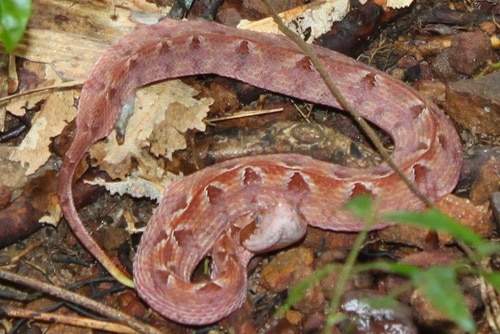
Many viper groups are enormous, with rattlesnakes (Crotalus genus) containing over 50 members and Trimeresurus green pitvipers containing over 40. But the Calloselasma genus has just one member, which lives a comfortable life in the leafy forests of Thailand and Vietnam: the Malayan pitviper (Calloselasma rhodostoma).
According to many statistics, this species contributes the greatest number of venomous snakebites in Vietnam, and easily the most deaths. For example, a 2001-2002 survey from Cho Ray Hospital in Ho Chi Minh City recorded 131 snakebites. Of the 93.1% which were venomous, 30.5% were caused by Malayan pitvipers. This was ahead of the branch-dwelling white-lipped pitviper in 2nd place, at 28.2%. Malayan pitvipers were also deadlier, as of the 6 deaths, they contributed 4.
Malayan pitvipers are lethal because of their camouflage. They’re a close parallel of the US copperhead, located thousands of miles away. Their camouflage is optimized to blend with leafy forest floors, and they’re a lazy ambush predator which goes days without moving. They have a thick body to knock over their prey using brute force, and they’re even a similar length, at 1-1.2 metres.
| 2 | Activates after nightfall |
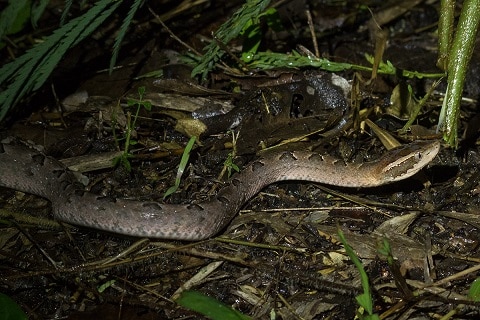
Calloselasma rhodostoma is one of the laziest vipers, burying themselves in leaf litter and not moving for days on end. They commonly overlap with green pitvipers such as Trimeresurus rubeus (ruby-eyed green pitviper), but this group sticks to branches 1-2 metres high instead, preventing competition. Malayan pitvipers are creatures of forests, including untouched deciduous forests, piles of timber near villages, and manmade rubber and palm oil plantations. This brings them into regular contact with the workers there, who must always tread carefully, and keep their eyes peeled for any serpentine vertical pupils staring back.
Many encounters with humans are of Malayan pitvipers crossing roads at night. This is a heavily nocturnal snake, and even while in stationary ambush position, they revive just minutes after nightfall. Like a statue coming to life, they shift subtly in their coils and begin tongue flecking for animal scents. It’s very rare to see a Malayan pitviper actively hunting during daylight.
Malayan pitvipers climb branches extremely rarely, and you’ll never find them slithering vertically up a building. In 2013, one was spotted 1 metre above ground on a barbed wire fence in southern Thailand’s Khanom District. Whether the spikes dug in painfully, or whether it weaved sinuously around them was hard to tell.
| 3 | Corrosive, destructive venom |
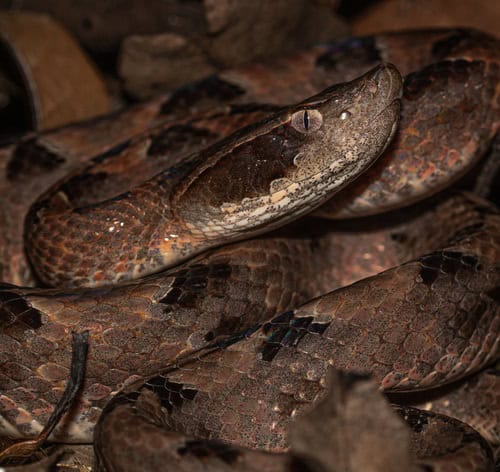
If a Malayan pitviper strikes your hand, losing one of your fingers is almost inevitable without immediate medical care. Their venom lacks paralysing neurotoxins, but features a potent viper cocktail of haemorrhagins and cytotoxins. Spontaneous bleeding is a hallmark, including from the nose, gums, and most worryingly, on the brain.
Their venom is especially rich in thrombin-like enzymes, a form of procoagulant. This triggers “consumption coagulopathy”, when toxins accelerate fibrinogen production and trigger the formation of many small clots throughout the bloodstream. This totally depletes the quantity required to clot blood during ordinary wounds, resulting in free bleeding.
This is combined with a direct assault on blood vessel structures. Malayan pitviper venom is rich in metalloproteinases which dissolve collagen in capillary membranes, causing them to burst. The most active of these is a unique toxin called rhodostoxin. This has dual function, as rhodostoxin is also responsible for part of the tissue necrosis.
Another unique toxin is rhodocetin, which prevents platelet aggregation, when cells plug together during early wound healing. A thrombin-like enzyme from Calloselasma rhodostoma called ancrod was being investigated as a stroke medication at one stage, although it failed to pass clinical trials.
| 4 | The longest fangs in Thailand |
Malayan pitvipers also have the longest fangs of any Thai snake. While they don’t quite match Africa’s gaboon adder at 2 inches, the snake with the longest fangs, they defeat the local green pitvipers and Russell’s vipers for length. This means that they inject venom deep into the victim’s tissue. Their blackening necrosis affects not just surface-level skin, but deep muscle and connective tissues. Without swift hospital care, this can end in gangrene and the amputation of the affected limb.
It’s estimated that an individual 1 metre long has a fang penetration depth of 1.6cm. The original goal of this was believed to be for predigesting prey, to inject cytotoxic compounds deep within their meal, to begin breaking down cells before swallowing to take the strain off their stomach acid.
The Malayan pitvipers’ bite marks are usually separated by 1.6-1.7cm. In larger snakes, this gap widens. An antivenom dedicated to this species is manufactured in Thailand, and stocked in most hospitals. But it’s a two-sided coin, as the antivenom is effective against systemic symptoms like haemorrhaging and consumption coagulopathy, but weak against tissue necrosis.
| 5 | Capable of large leaps |
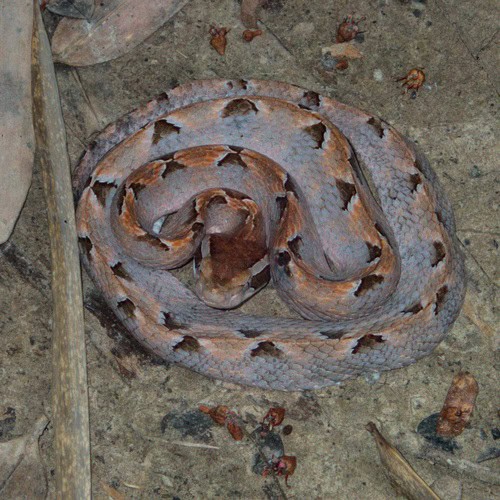
Unpredictability is another hallmark of Calloselasma rhodostoma. They can be calm one moment, even when held, before erupting into a savage display of aggression the next minute.
Malayan pitvipers can strike without any warning. If they are generous enough, then they’ll warn victims using an S-shaped coil, kinked at the neck, with a loud hiss. They can make short strikes advancing a few inches, or sudden leaps that advance them by over half their body length. Malayan pitvipers strike at an extremely fast speed given their usual laziness.
While Malayan pitvipers aren’t über-common, they cover a decent swathe of territory. They inhabit virtually the entirety of Thailand, the southern half of Vietnam and most of Cambodia. They’re also abundant on Java, including near the Indonesian capital of Jakarta, and have sightings in southern Myanmar. They’re not found in Singapore, the Philippines or Sumatra. Nor do they reach southern China, India or Bangladesh.
| 6 | Lures prey with its tail |
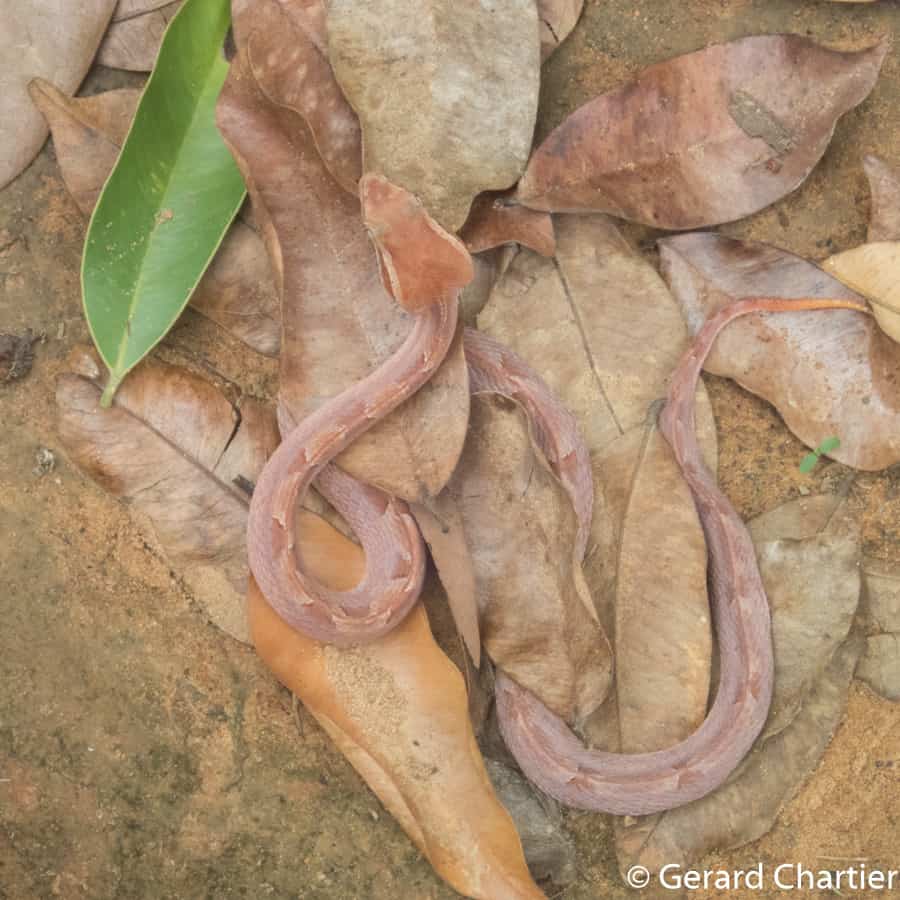
One predatory skill found mainly in vipers is caudal luring, a colourful tail tip designed to lure in prey. Many images show Malayan pitvipers with a pinkish body, yet a bright orange tail tip. This is found across the New World vipers and some of the Old World ones. Caudal luring pop ups in most viper families, including Agkistrodon (copperheads, cottonmouths), the Lachesis bushmasters and Trimeresurus green pitvipers.
To accomplish their luring goals, Malayan pitvipers hold their entire tail vertical, and making steady undulations, like a hypnotist’s watch. Malayan pitvipers stay completely still while swaying their tail, and cease flecking their tongue. In a captive experiment in 1983, scientists watched on as a northern leopard frog hopped into view and noticed this wiggling tail curiously. It advanced towards its prize, only for the Malayan pitviper to pounce and swallow it whole.
This snake was a juvenile, as into adulthood, the tail tip of Calloselasma rhodostoma turns grey, and loses its luring abilities. This is typical, as only an elite handful of species keep a bright tail all their lives, including the Brazilian snake Bothrops bilineatus. No cobra species uses caudal luring.
| 7 | Deaths are rare, but confirmed |
A 2005 study analysed the Malayan pitviper’s bite symptoms on a large scale. 225 victims were studied from Thailand, with 145 freshly studied victims and 80 from archived hospital records. 94-95% of victims experienced necrosis at the bite site. 15.9% of the new patients had severe local necrosis. There were no amputations, compared to 2.2% of patients receiving amputations in an earlier 1986 study. However, 18.6% of the 145 new victims ended up with permanently swollen limbs, due to lymphatic and vascular damage. The mean duration of hospitalisation was 3-5 days.
2 victims died, and both deaths were caused by intercranial haemorrhage, the disintegration of blood vessel linings causing brain bleeding. The first victim was a 60 year old man who had delayed visiting hospital for 3 days. After the Malayan pitviper struck, he had sought help from local healers using herbal remedies and potions. When he was finally brought to the emergency room, he was comatose and suffering from severe local tissue damage. This death wasn’t exactly surprising.
In the second case, a 72 year old man wisely visited hospital within 1 hour. His symptoms were mild on day 1, but on day 2, he began bleeding from the gums. That afternoon, he went into shock, fell unconscious, and later died. The explanation here was that the hospital had run out of antivenom supplies.
| 8 | Prefers sticky, humid nights |
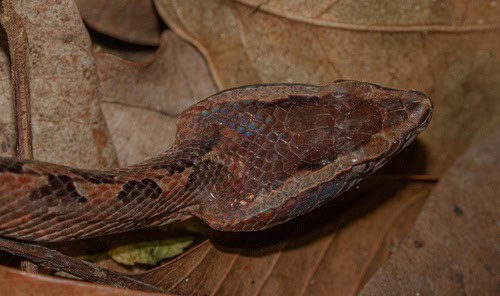
We know the most likely location to meet Calloselasma rhodostoma – deciduous forests and rubber plantations coated with a thick bed of leaves. We know that nighttime is riskiest, but the worst time to meet them of all is sticky, humid nights. A 1994 study followed 14 radiotracked adult Malayan pitvipers, in a plantation estate of Kedah state in western Malaysia. Over 5 months, 887 observations were made of the radiotracked snakes.
Their movements had no correlation with rainfall, temperature or the lunar cycle. But there was a close positive correlation with humidity. As the stickiness rose, Malayan pitvipers exposed more of their bodies to view, indicating aggression, while during low humidity, they retreated to areas of deeper undergrowth.
The study also confirmed how Malayan pitvipers went days on end without moving, sticking to one ambush spot. However, once they abandoned a spot, they never returned to it. The average movement to a new position was 5 metres, but some snakes moved as far as 128 metres, usually in a direct line, as though they knew their destination. The pitvipers moved during daylight only rarely, and only by tiny distances of less than 1 metre.
| 9 | Coils around its eggs for weeks |
Despite their vicious reputation, rattlesnakes are perhaps the most caring snake group on Earth. Though some species abandon their young, Arizona black rattlesnakes live in mountain communities and seemingly have friends. Female prairie rattlesnakes guard the offspring of other mothers while they venture out from caves to hunt. Calloselasma rhodostoma is another pitviper with proven maternal instincts. Unlike rattlesnakes, they lay eggs rather than live young. Scientists radiotracked a Malayan pitviper in northeast Thailand, who laid 3 eggs from August 11-24th 2004. These were laid in a rock crack on a slope in a deciduous dipterocarp forest. The eggs eventually hatched, beginning on October 10th, and for the entire intubation, the mother coiled around and protected the eggs. She only ate once during the intubation, and shed her skin once.
The den had a concealed entrance, which was 30cm wide and 13cm tall between two rock slabs, but partially hidden by fallen leaves and twigs. In July, after she first arrived, scientists found scratches on the soil outside, like a predatory mammal had tried and failed to enter the den.
Unlike a rattlesnake, she seemingly abandoned her eggs once they’d hatched, as she was soon found 58 metres away. But she was willing to sacrifice nearly 2 months to ensure their future success. On November 15th, scientists removed her radio-transmitter, and found that she had grown by 5cm over the 165 day study.
| 10 | Fears the king cobra |
Malayan pitvipers have one of the most varied diets for a viper. Mammals, reptiles, birds and amphibians are all on their menu. In captivity they’ve committed cannibalism before, and happily accepted amphibians such as Woodhouse’s toad and northern cricket frogs. Six younglings consumed a fish species, the golden shiner.
Like most vipers, juveniles feed more heavily on cold-blooded ectotherms, such as lizards, while adults graduate to endotherms. Calloselasma rhodostoma tends to target prey approximately one third of its body weight. They usually release larger prey before swallowing. Mice tend to lose mobility rapidly, but take a while to die, with many spasms and twitches. Malayan pitvipers occupy a very brutal corner of nature.
Meanwhile, their own confirmed predators include the king cobra and gold-ringed catsnake (Boiga dendrophilia). King cobras derive 95-99% of their calories from fellow snakes and couldn’t care less about swallowing venom glands whole. Both species inhabit forests with leafy floors, and are likely to meet.
